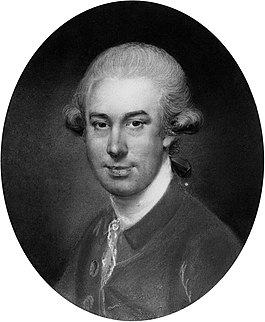Related Research Articles

Sir Godfrey Kneller, 1st Baronet, was the leading portrait painter in England during the late 17th and early 18th centuries, and was court painter to English and British monarchs from Charles II to George I. His major works include The Chinese Convert ; a series of four portraits of Isaac Newton painted at various junctures of the latter's life; a series of ten reigning European monarchs, including King Louis XIV of France; over 40 "kit-cat portraits" of members of the Kit-Cat Club; and ten "beauties" of the court of William III, to match a similar series of ten of Charles II's mistresses painted by Kneller's predecessor as court painter, Sir Peter Lely.

Thomas Phillips RA was a leading English portrait and subject painter. He painted many of the great men of the day including scientists, artists, writers, poets and explorers.

John Russell RA was an English painter renowned for his portrait work in oils and pastels, and as a writer and teacher of painting techniques.

Sawrey Gilpin was an English animal painter, illustrator, and etcher who specialised in paintings of horses and dogs. He was made a Royal Academician.

Peter De Wint was an English landscape painter. A number of his pictures are in the National Gallery, the Victoria and Albert Museum and The Collection, Lincoln. He died in London.

William Hilton was a British portrait and history painter. He is also known as "William Hilton the Younger".

John Raphael Smith was a British painter and mezzotinter. He was the son of Thomas Smith of Derby, the landscape painter, and father of John Rubens Smith, a painter who emigrated to the United States.
Sophie Gengembre Anderson was a French-born British artist who specialised in genre painting of children and women, typically in rural settings. She began her career as a lithographer and painter of portraits, collaborating with Walter Anderson on portraits of American Episcopal bishops. Her work, Elaine, was the first public collection purchase of a woman artist. Her painting No Walk Today was purchased for more than £1 million.

George Barret Sr. was an Irish landscape artist best known for his oil paintings, but also sometimes produced watercolours. He left Ireland in 1762 to move to London where he soon gained recognition as a leading artist of the period. He exhibited at the Society of Artists of Great Britain and was able to gain patronage from many leading art collectors. Barrett with other leading members left the Society in 1768 to found the Royal Academy, where he continued to exhibit until 1782.

John Hamilton Mortimer was a British figure and landscape painter and printmaker, known for romantic paintings set in Italy, works depicting conversations, and works drawn in the 1770s portraying war scenes, similar to those of Salvator Rosa.

Arthur Devis was an English artist, half-brother of the painter Anthony Devis (1729–1816), and father of painters Thomas Anthony Devis (1757–1810) and Arthur William Devis (1762–1822). His place in the pages of art history is generally as a painter of the type of portrait now called a conversation piece.

George Lambert was an English landscape artist and theatre scene painter. With Richard Wilson he is recognised as a pioneer of British landscape in art, for its own sake.

Samuel Scott was a British landscape painter known for his riverside scenes and seascapes.

Charles Catton RA, sometimes referred to as Charles Catton the elder, was a notable English coach painter, landscape, animal and figure painter of the late 18th century, and one of the founder members of the Royal Academy of Arts.
Mary Harrison was an English flower and fruit painter, and illustrator. She became popularly called the "Rose and Primrose painter". She has also been known as Mary P. Harrison and Mary Rossiter Harrison.

John "Warwick" Smith was a British watercolour landscape painter and illustrator.

William Pars was an English watercolour portrait and landscape painter, draughtsman, and illustrator.
Elizabeth Creed was an English artist and philanthropist.
Samuel Wathen, M. D. was an English physician who practised in London during the Georgian era. He acted as personal physician to Rev. John Wesley, and may also have served Queen Charlotte of England as a male midwife.

Joseph Samuel Webster was an English portrait painter who worked in miniatures, oils, pastels, and crayons.
References
![]() This article incorporates text from a publication now in the public domain : "Clayton, John (1728-1800)". Dictionary of National Biography . London: Smith, Elder & Co. 1885–1900.
This article incorporates text from a publication now in the public domain : "Clayton, John (1728-1800)". Dictionary of National Biography . London: Smith, Elder & Co. 1885–1900.